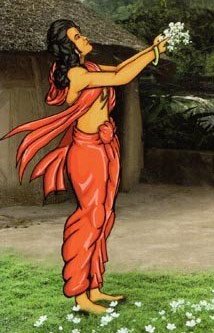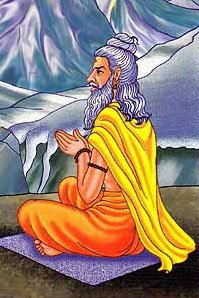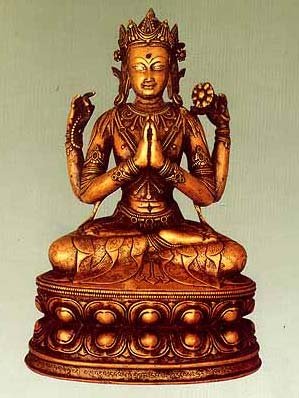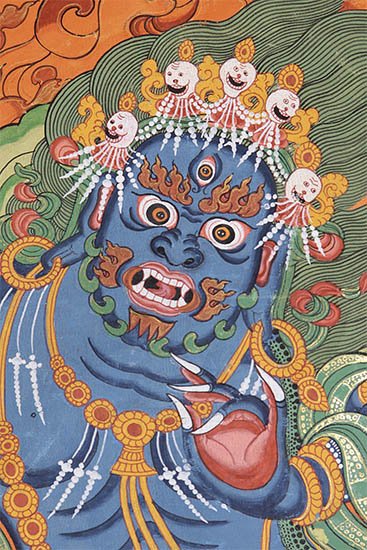Dharmagupta, Dharma-gupta: 12 definitions
Introduction:
Dharmagupta means something in Buddhism, Pali, Hinduism, Sanskrit. If you want to know the exact meaning, history, etymology or English translation of this term then check out the descriptions on this page. Add your comment or reference to a book if you want to contribute to this summary article.
In Hinduism
Kavya (poetry)
Source: Wisdom Library: Kathāsaritsāgara1) Dharmagupta (धर्मगुप्त) is the name of a merchant whose daughter was named Devasmitā, according to a story in the Kathāsaritsāgara, chapter 13. Devasmitā was to be married to Guhasena (son of Dhanadatta) but Dharmagupta did, in first instance, not agree to this. The story of Devasmitā was told by Vasantaka to Vāsavadattā in order to divert her thoughts as she was anxiously awaiting her marriage with Udayana.
2) Dharmagupta (धर्मगुप्त) is the name of a richt merchant from the city Pāṭaliputra, according to the Kathāsaritsāgara, chapter 17. His wife Candraprabhā gave birth to an apsaras (heavenly nymph) named Somaprabhā. Their story was told by Vasantaka to Padmāvatī and queen Vāsavadattā.
The Kathāsaritsāgara (‘ocean of streams of story’), mentioning Dharmagupta, is a famous Sanskrit epic story revolving around prince Naravāhanadatta and his quest to become the emperor of the vidyādharas (celestial beings). The work is said to have been an adaptation of Guṇāḍhya’s Bṛhatkathā consisting of 100,000 verses, which in turn is part of a larger work containing 700,000 verses.

Kavya (काव्य, kavya) refers to Sanskrit poetry, a popular ancient Indian tradition of literature. There have been many Sanskrit poets over the ages, hailing from ancient India and beyond. This topic includes mahakavya, or ‘epic poetry’ and natya, or ‘dramatic poetry’.
Purana and Itihasa (epic history)
Source: archive.org: Puranic Encyclopedia1) Dharmagupta (धर्मगुप्त).—A prince who obtained blessings from Śiva by observing the Pradoṣavrata. (For detailed story see Aṃśumatī).
2) Dharmagupta (धर्मगुप्त).—A Nandarājakumāra belonging to the Lunar dynasty. Chapters 1, 2 and 13 of Skanda Purāṇa gives the following story about him.
(See full article at Story of Dharmagupta from the Puranic encyclopaedia by Vettam Mani)

The Purana (पुराण, purāṇas) refers to Sanskrit literature preserving ancient India’s vast cultural history, including historical legends, religious ceremonies, various arts and sciences. The eighteen mahapuranas total over 400,000 shlokas (metrical couplets) and date to at least several centuries BCE.
In Buddhism
Mahayana (major branch of Buddhism)
Source: Wisdom Library: LokottaravādaDharmagupta (धर्मगुप्त) is the name of a Buddha under whom Śākyamuni (or Gautama, ‘the historical Buddha’) acquired merit along the first through nine bhūmis, according to the Mahāvastu. There are in total ten bhūmis representing the ten stages of the Bodhisattva’s path towards enlightenment.
Dharmagupta is but one among the 500 Buddhas enumerated in the Mahāvastu during a conversation between Mahākātyāyana and Mahākāśyapa, both principle disciples of Gautama Buddha. The Mahāvastu is an important text of the Lokottaravāda school of buddhism, dating from the 2nd century BCE.

Mahayana (महायान, mahāyāna) is a major branch of Buddhism focusing on the path of a Bodhisattva (spiritual aspirants/ enlightened beings). Extant literature is vast and primarely composed in the Sanskrit language. There are many sūtras of which some of the earliest are the various Prajñāpāramitā sūtras.
Tibetan Buddhism (Vajrayana or tantric Buddhism)
Source: Wisdom Library: Tibetan BuddhismDharmagupta (धर्मगुप्त) [=dharmaguptaka] refers to one of the Eighteen Sects (of the Vaibhāṣika) [classified as Sarvāstivāda] known in Tibetan as bye brag smra ba'i gyes pa bco brgyad.—Cf. the writings of Vinītadeva (8th century): an Indian scholar and author who was active at the ancient Nalanda university where he produced commentaries on both the Triṃśikā and the Viṃśatikā which survive in Tibetan translation and some Sanskrit fragments.

Tibetan Buddhism includes schools such as Nyingma, Kadampa, Kagyu and Gelug. Their primary canon of literature is divided in two broad categories: The Kangyur, which consists of Buddha’s words, and the Tengyur, which includes commentaries from various sources. Esotericism and tantra techniques (vajrayāna) are collected indepently.
General definition (in Buddhism)
Source: Buddhist Door: GlossaryHe translated the Lotus Sutra in A.D. 601 jointly with Jnanagupta.Source: SgForums: BuddhismDharmaguptah - a subdivision of Sarvastivadah, developed from Mahisasakah and located in northwest India and Central Asia. Literally means those who protect (or preserve) the Law. They were instrumental informing the cult of the stupa, and were expert in incantation.
Languages of India and abroad
Sanskrit dictionary
Source: DDSA: The practical Sanskrit-English dictionaryDharmagupta (धर्मगुप्त).—a. observing and protecting religion.
-ptaḥ Name of Viṣṇu.
Dharmagupta is a Sanskrit compound consisting of the terms dharma and gupta (गुप्त).
Source: Cologne Digital Sanskrit Dictionaries: Edgerton Buddhist Hybrid Sanskrit DictionaryDharmagupta (धर्मगुप्त).—(1) name of a former Buddha: Mahāvastu i.138.8 (and by Senart's em. for °gupti, q.v.); (2) pl. (= Pali Dhammagutta), name of a Buddhist school: Mahāvyutpatti 9081.
Source: Cologne Digital Sanskrit Dictionaries: Aufrecht Catalogus CatalogorumDharmagupta (धर्मगुप्त) as mentioned in Aufrecht’s Catalogus Catalogorum:—son of Rāmadāsa, wrote in 1360: Rāmāṅkanāṭikā. Bendall Catal. p. 87.
Source: Cologne Digital Sanskrit Dictionaries: Monier-Williams Sanskrit-English Dictionary1) Dharmagupta (धर्मगुप्त):—[=dharma-gupta] [from dharma > dhara] m. ‘l°-protected’, Name of men, [Kathāsaritsāgara; Skanda-purāṇa] (also -miśra), of a poet, [Catalogue(s)]
2) [v.s. ...] of a Buddh. school
[Sanskrit to German]
Sanskrit, also spelled संस्कृतम् (saṃskṛtam), is an ancient language of India commonly seen as the grandmother of the Indo-European language family (even English!). Closely allied with Prakrit and Pali, Sanskrit is more exhaustive in both grammar and terms and has the most extensive collection of literature in the world, greatly surpassing its sister-languages Greek and Latin.
See also (Relevant definitions)
Partial matches: Gupta, Tarma, Dharma.
Starts with: Dharmaguptacarita, Dharmaguptah, Dharmaguptaka, Dharmaguptamishra.
Query error!
Full-text: Dharmaguptacarita, Jnanagupta, Ramadasa, Ramanka natika, Dharmaguptah, Devasmita, Amshumati, Mulasarvastivada, Guhacandra, Eighteen Hinayana Sects, Guhasena, Kotikarna, Somaprabha, Candraprabha.
Relevant text
Search found 24 books and stories containing Dharmagupta, Dharma-gupta, Dharmaguptas; (plurals include: Dharmaguptas, guptas, Dharmaguptases). You can also click to the full overview containing English textual excerpts. Below are direct links for the most relevant articles:
Dipavamsa (study) (by Sibani Barman)
Puranic encyclopaedia (by Vettam Mani)
Maha Prajnaparamita Sastra (by Gelongma Karma Migme Chödrön)
Story of Kokālika’s mendacious accusations < [Section I.4 - Abstention from falsehood]
Appendix 2 - The journey of the Buddha to southern India and Koṭikarṇa < [Chapter XV - The Arrival of the Bodhisattvas of the Ten Directions]
Appendix 13 - Notes on the stanzas spoken by Vaiśravaṇa in honor of the Buddha < [Chapter VIII - The Bodhisattvas]
Skanda Purana (by G. V. Tagare)
Chapter 32 - The Glory of Dhanuṣkoṭi: Dharmagupta Gets Rid of his Madness < [Section 1 - Setu-māhātmya]
Chapter 13 - The Greatness of Svāmipuṣkariṇī: Dharmagupta < [Section 1 - Veṅkaṭācala-māhātmya]
Chapter 7 - The Importance of Pradoṣa: The Procedure of Śiva’s Worship < [Section 3 - Brāhmottara-khaṇḍa]
Mahavastu (great story) (by J. J. Jones)
Chapter XV - The eighth Bhūmi < [Volume I]
Buddha-nature (as Depicted in the Lankavatara-sutra) (by Nguyen Dac Sy)
2. Middle period (c): The Mahāyānasaṃparigraha-śāstra < [Chapter 2 - The Buddha-Nature in the Tathāgatagarbha Literature]